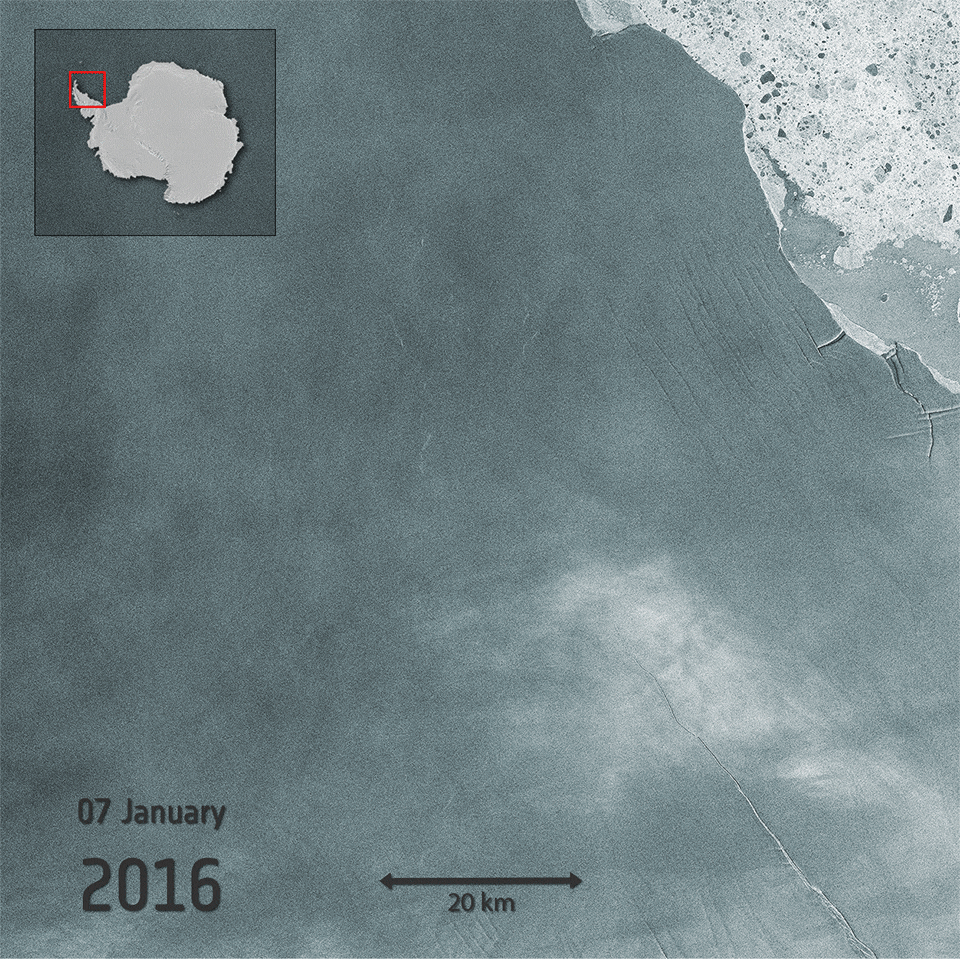http://www.esa.int/esl/ESA_in_your_country/Spain/La_grieta_de_Larsen_C
La grieta de Larsen C
1 febrero 2017
Hace ya varios años que apareció una grieta en la barrera de hielo Larsen C de la península Antártica, pero en los últimos tiempos ha ido creciendo más rápido que nunca.
Gracias a sus radares con ‘visión nocturna’, los satélites Sentinel-1 de Copernicus están vigilando la situación.
Esta animación muestra que la fisura se ha extendido unos 60 km desde enero del año pasado. Y desde principios de enero de este año, se han separado otros 20 km, por lo que, en estos momentos, la plataforma de 350 m de grosor apenas se encuentra unida por un hilo a la península. La grieta ahora tiene unos 175 km de longitud.
Cuando el iceberg se separe definitivamente de la barrera de hielo, será uno de los mayores nunca registrados, aunque es difícil pronosticar cuándo sucederá. Las barreras colindantes, Larsen A y Larsen B experimentaron un proceso similar, con partos espectaculares en 1995 y 2002, respectivamente.
Estas barreras de hielo son importantes, ya que actúan a modo de refuerzo, reteniendo el hielo que fluye hacia el mar.
Los dos satélites Sentinel-1 son fundamentales para descubrir y vigilar acontecimientos como estos, ya que son capaces de proporcionar imágenes de radar de forma continua, a pesar de que la Antártida permanece inmersa en la oscuridad durante varios meses al año.
English Versión:

- Title Larsen crack
- Released 30/01/2017 9:19 am
- Copyright contains modified Copernicus Sentinel data (2016–17), processed by ESA
- DescriptionA crack in the Larsen-C ice shelf in on the Antarctic Peninsula first appeared several years ago, but recently it has been lengthening faster than before. Carrying radar that can ‘see’ through the dark, the Copernicus Sentinel-1 satellites are monitoring the situation. The animation shows that the fissure has opened around 60 km since January last year. And, since the beginning of this January it has split a further 20 km so that the 350 m-thick shelf is held only by a thread. The crack now extends around 175 km.When the ice shelf calves this iceberg it will be one of the largest ever recorded – but exactly how long this will take is difficult to predict. The neighbouring Larsen-A and Larsen-B ice shelves suffered a similar fate with dramatic calving events in 1995 and 2002, respectively.These ice shelves are important because they act as buttresses, holding back the ice that flows towards the sea.The Sentinel-1 two-satellite constellation is indispensable for discovering and monitoring events like these because it continues to deliver radar images when Antarctica is shrouded in darkness for several months of the year.
- Id 372459
Guillermo Gonzalo Sánchez Achutegui
ayabaca@gmail.com
ayabaca@hotmail.com
ayabaca@yahoo.com
Inscríbete en el Foro del blog y participa : A Vuelo De Un Quinde - El Foro!


No hay comentarios:
Publicar un comentario